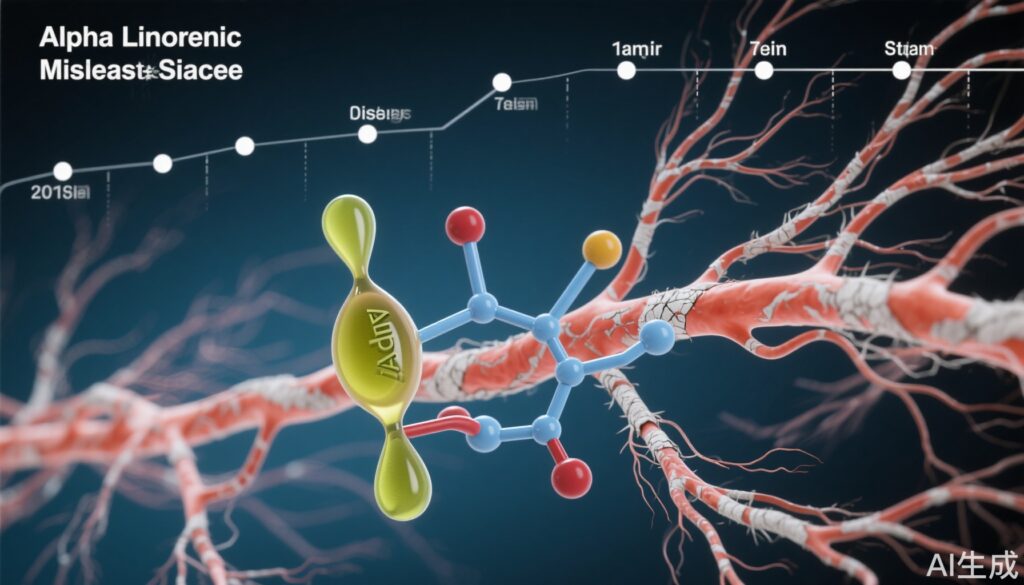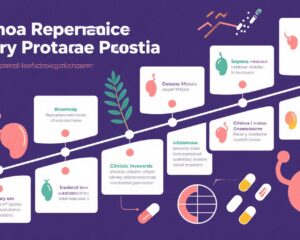Highlights
- Higher serum alpha-linolenic acid (ALA), a plant-derived omega-3 fatty acid, is associated with significantly lower risk of clinically definite multiple sclerosis (CDMS) and relapses up to 11 years post-onset.
- ALA’s protective association extends to slower disability progression measured by MS Functional Composite but lacks strong correlation with cognitive function, brain atrophy, or lesion activity.
- Other serum polyunsaturated fatty acids (PUFAs) demonstrate inconsistent or null associations with long-term MS outcomes, highlighting ALA’s unique potential biological role.
- The BENEFIT trial provides methodologically robust prospective evidence using gas chromatography-based fatty acid profiling and multiple regression analyses in a large, well-characterized MS cohort.
Background
Multiple sclerosis (MS) is a chronic immune-mediated demyelinating disease of the central nervous system characterized by episodic inflammation and progressive neurodegeneration leading to disability. Despite advances in disease-modifying therapies, prognostic biomarkers that predict long-term disease activity and progression remain limited. Dietary factors, particularly polyunsaturated fatty acids (PUFAs), have garnered interest given their immunomodulatory and neuroprotective properties. Alpha-linolenic acid (ALA) is a plant-derived omega-3 PUFA found in flaxseed, walnuts, and leafy greens, hypothesized to confer neuroimmune benefits.
Previous epidemiological data suggested higher dietary ALA intake may reduce MS risk and relapse activity. However, longitudinal clinical evidence measuring circulating serum ALA levels and linking them directly with MS outcomes over extended follow-up was lacking until the recent BENEFIT trial analyses.
Key Content
Study Design and Methods
The BENEFIT (Betaferon/Betaseron in Newly Emerging Multiple Sclerosis For Initial Treatment) trial was a prospective, longitudinal clinical study enrolling 468 participants with initial demyelinating events suspected of MS. Blood samples for serum fatty acid quantification commenced at randomization, followed over 5 to 11 years. Fatty acid profiles were quantified by gas chromatography—a gold standard analytical technique.
Primary outcomes included time to clinically definite MS (CDMS) diagnosis, relapse rates, disability progression (measured by MS Functional Composite and Expanded Disability Status Scale [EDSS]), and radiological measures such as active lesions and brain volume change. Statistical analyses employed Cox proportional hazards models for disease conversion, negative binomial regression for relapse count, and linear regression for disability metrics, adjusting for relevant confounders.
Findings on Serum ALA and MS Activity
Higher baseline serum ALA levels strongly correlated with lower hazards of conversion to CDMS, with multivariable-adjusted hazard ratios (HRs) of approximately 0.60 when comparing highest versus lowest ALA quartiles at both 5- and 11-year timepoints. This represents a 40% risk reduction. Similar protective associations emerged regarding relapse incidence, with adjusted risk ratios (RRs) also near 0.60-0.65.
In contrast, among 35 other measured serum fatty acids, none demonstrated consistent significant associations with CDMS conversion risk. Three fatty acids showed some relation to relapse rate at 5 years but not at 11 years, underscoring the specific and sustained relationship of ALA.
Disability Progression and Functional Outcomes
Higher ALA predicted a slower decline in MS Functional Composite scores at 5 years, indicative of reduced disability progression. Although the 11-year data showed a continuing trend, statistical significance was not retained, potentially due to reduced sample size or competing factors.
Interestingly, baseline ALA was not associated with changes in cognitive function, measured by neuropsychometric testing, or with MRI metrics such as new active lesion formation or brain atrophy rates, suggesting ALA’s effects may primarily modulate early inflammatory processes more than neurodegeneration or cognitive domains.
Comparison with Other PUFAs
The study’s comprehensive fatty acid profiling found null or inconsistent results for other omega-3 and omega-6 fatty acids such as eicosapentaenoic acid (EPA), docosahexaenoic acid (DHA), and arachidonic acid. This highlights ALA’s distinct biological or metabolic role, possibly related to its precursor status or unique anti-inflammatory pathways.
Expert Commentary
The BENEFIT study represents a significant advance by linking objectively measured serum fatty acid biomarkers with long-term MS clinical outcomes in a rigorously characterized cohort. ALA’s robust protective association supports earlier epidemiological findings and refines understanding by decoupling it from other PUFAs.
Mechanistically, ALA may exert immunomodulatory effects by influencing T-cell activation, cytokine production, or membrane lipid composition, promoting an anti-inflammatory milieu in the central nervous system. Alternatively, ALA may be metabolized into downstream bioactive lipid mediators contributing to neuroprotection.
However, lack of correlation with MRI lesion activity or brain atrophy suggests that ALA might impact peripheral immune mechanisms or early lesion formation rather than established neurodegeneration. The absence of an effect on cognitive decline warrants further investigation, potentially incorporating larger cohorts and more sensitive cognitive measures.
Limitations include potential residual confounding by diet, lifestyle, or genetic factors influencing fatty acid metabolism. While serum levels are objective, single timepoint measurements may not fully capture dynamic PUFA status over disease course.
The findings also raise intriguing clinical translational questions about the utility of ALA supplementation or dietary modification as a low-risk adjunct in early MS management. Randomized controlled trials assessing ALA intake or supplementation effects on clinical and radiological outcomes could clarify causality and therapeutic potential.
Conclusion
This comprehensive prospective study firmly establishes higher serum alpha-linolenic acid levels as a predictor of reduced MS activity and relapse risk over more than a decade of follow-up. The data advocate for further mechanistic studies and clinical trials exploring ALA’s neuroimmune benefits and incorporation into personalized dietary recommendations for MS patients.
While other serum fatty acids do not show consistent protective associations, ALA’s unique profile highlights the nuanced roles of PUFAs in immune-mediated neuroinflammatory diseases.
References
- Cortese M, Peng X, Edan G, Freedman MS, Hartung HP, Montalban X, Sandbrink R, Radü EW, Barkhof F, Wicklein EM, Kappos L, Ascherio A, Bjornevik K; BENEFIT Study Group. Serum Alpha-Linolenic Acid and Long-Term Multiple Sclerosis Activity and Progression. Neurology. 2025 Aug 12;105(3):e213905. doi: 10.1212/WNL.0000000000213905. PMID: 40674673.
- Simopoulos AP. Omega-3 fatty acids in inflammation and autoimmune diseases. J Am Coll Nutr. 2002;21(6):495-505. PMID: 12480794.
- Gross RA, Bellenger JP. Polyunsaturated fatty acids and multiple sclerosis: implications for pathogenesis and therapy. CNS Neurosci Ther. 2013;19(3):219-231. doi:10.1111/cns.12057. PMID: 23414147.
- Dahlqvist T, Beyer C. Mechanisms of Dietary Polyunsaturated Fatty Acids in Multiple Sclerosis. Neuroscience. 2020;437:69-83. doi: 10.1016/j.neuroscience.2020.04.012. PMID: 32387810.


